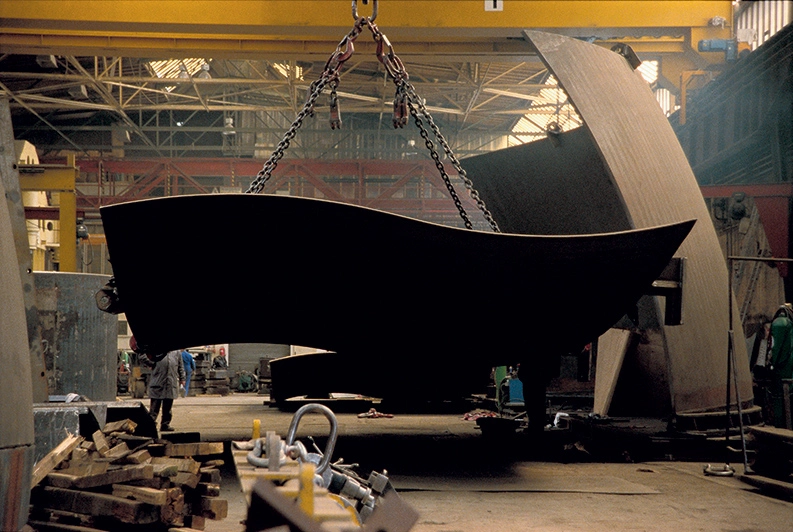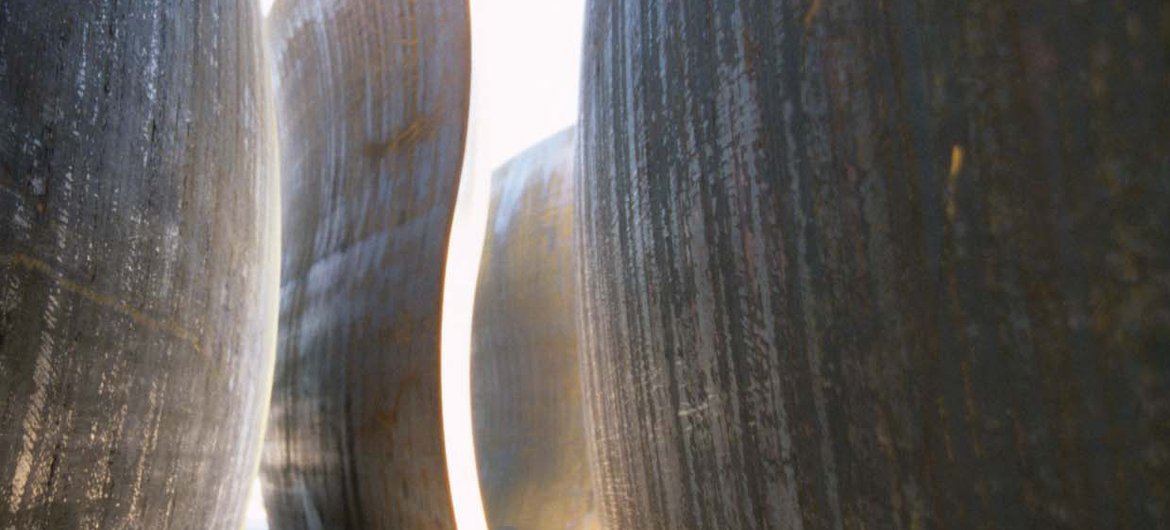Year: 2003-2004
Material/Technique: Corten steel plates
Serra has created one of his greatest outdoor steel sculptures for the Novartis Campus between 2003 and 2004. The sculpture comprises five identical elements each 15 meters long and 5 meters high, which narrow sharply at either end, each of which consists of two dynamically curved steel plates placed flush against one another. All five elements are parallel and are aligned on the Fabrikstrasse, but they have four different longitudinal axes. Two elements stand behind one another on the same axis, the central axis of the Fabrikstrasse, while the other three each have a separate one, two to the west of that central axis and one to the east of it. The elements also have four different lateral axes: two elements stand exactly opposite one another while the others are staggered and overlap by only around one half of their length. The work’s title suggests the association of the five-steel sculpture with a group of whales.
The sculpture –both its separate elements seen from close up and more specifically the entire cluster of its interacting elements- has a different impact depending on where we stand.
Serra dedicated the sculpture to his longtime friend and official photographer Dirk Reinartz who died unexpectedly in 2004 and who had photographed Serra’s work for almost 30 years.

In the words of Richard Serra: “The module for “Dirk’s Pod’ was developed from an analysis of simple toruses which led to using two toroid sections to form an S-shaped plate: a double torus. Each module is identical and comprised of two S-sections which are inverted in relationship to each other. As the S-sections close together, the concavity and convexity of one side lock to the concavity and convexity of the other side. The five modules are located so that they counter each other by rotation and inversion producing varying spaces in between. The voids that result between the five modules form four different kind of spaces: bottle-shaped, upside-down bottle-shaped, and spaces created by paralleling S-shaped sides which lean either to the right or to the left. […] As you walk through the pod, you become physically implicated in the force of the fluid space, solid and void are equally activated. As you attempt to project a trajectory, you find that your directionality is challenged. The rhythm of your movement takes its cue from the rhythm of the sculpture and will determine the path you take. […]
I have attempted for the last 30 years with varying degrees of success and failure to place my work in public spaces throughout the world. It is an act of assertion, an act derived from the knowledge of the potential tor sculpture and an act of faith. Basically, I want to make sculpture that stands for a new order of experience, that represents a sculptural possibility that did not exist before. I hope it will last. That’s all. But that is everything because there are no guarantees. It is a large desire but also very simple. To make a sculpture that stands for and contains a complexity of experiences, that becomes something that anyone can relate to, that anyone can walk into and through and respond to.”

Artist
Richard Serra was born in San Francisco in 1938. He currently lives and works in New York and on the North Fork of Long Island. Serra attended the University of California, Berkeley before transferring to the University of California, Santa Barbara graduating with a BA in English literature; he then studied painting at Yale University, New Haven, Connecticut completing both a BFA and MFA.
He is best known for the monumental steel outdoor sculptures he has made since the 1970s; several of these have sparked public controversies—including in Basel, where his sculpture Intersection on Theaterplatz is a striking sight in the urban fabric.
He was exposed early to the processes of metalwork; his father worked as a pipe fitter in the shipbuilding industry, and Richard worked in steel mills during his college years. Serra creates elicit complex as aesthetic experiences that speak forcefully to our relationship with our surroundings—be it the built urban environment or a landscape—and our perception of the world.
Since the late 1960's he participates in important international art exhibitions. Serra's work can be found in many international public and private collections, including the Museum of Modern Art and the Solomon R. Guggenheim Museum in New York, the Los Angeles County Museum of Art, and the San Francisco Museum of Modern Art. Since the early 1970s, Serra has completed many private commissions, most of them funded in Europe.
Other information
Silke von Berswordt-Wallrabe (ed.), Dirk's Pod by Richard Serra, Photographs by Dirk Reinartz and Nic Tenwiggenhorn. Catalogue. Steidl 2005.
